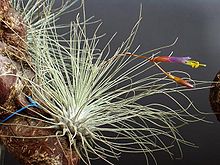
Tillandsia is a genus of around 650 species of evergreen, perennial flowering plants in the family Bromeliaceae, native to the forests, mountains and deserts of the Neotropics, from northern Mexico and the southeastern United States to Mesoamerica and the Caribbean to central Argentina. Their leaves, more or less silvery in color, are covered with specialized cells (trichomes) capable of rapidly absorbing water that gathers on them.

Pelargonium is a genus of flowering plants that includes about 280 species of perennials, succulents, and shrubs, commonly called geraniums, pelargoniums, or storksbills. Geranium is also the botanical name and common name of a separate genus of related plants, also known as cranesbills. Both genera belong to the family Geraniaceae. Carl Linnaeus originally included all the species in one genus, Geranium, and they were later separated into two genera by Charles Louis L'Héritier de Brutelle in 1789.

Saxifraga is the largest genus in the family Saxifragaceae, containing about 473 species of holarctic perennial plants, known as saxifrages or rockfoils. The Latin word saxifraga means literally "stone-breaker", from Latin saxum + frangere. It is usually thought to indicate a medicinal use for treatment of urinary calculi, rather than breaking rocks apart.

Salvia argentea, the silver sage, silver salvia, or silver clary, is a biennial or short-lived perennial plant that is native to an area in southern Europe from Portugal to Bulgaria. Its Latin specific epithet argentea means "silvery", referring to the colour of the leaves.

Celosia argentea, commonly known as the plumed cockscomb or silver cock's comb, is a herbaceous plant of tropical origin in the Amaranthaceae family from India and Nepal. The plant is known for its very bright colors. In India and China it is known as a troublesome weed.

Dichondra is a small genus of flowering plants in the morning glory family, Convolvulaceae. They are prostrate, perennial, herbaceous plants, with creeping stems which take root readily at the leaf nodes. The flowers are white, greenish or yellowish, 2–3 mm (0.079–0.118 in) diameter. Members of the genus are commonly known as ponysfoots and are native to tropical and cool temperate regions around the world.

Tillandsia excelsa is a species of flowering plant in the family Bromeliaceae. It is native to Central America, Cuba, Jamaica, and the Dominican Republic.

Hoheria is a genus of six species of flowering plants in the family Malvaceae. All are endemic to New Zealand. The genus name is a latinization of the Māori language name, houhere. That name, as well as lacebark and ribbonwood, are often used as common names. The name lacebark comes from the lace-like fibrous inner bark layer.

Oscularia deltoides, the deltoid-leaved dewplant, dassievygie or sandsteenvygie is a species of flowering succulent plant in the fig-marigold family Aizoaceae that is native to the south-western Cape, South Africa.

Tillandsia ixioides is a species of flowering plant in the family Bromeliaceae. It is native to South America. Two subspecies are recognized:
- Tillandsia ixioides subsp. ixioides – Bolivia, Uruguay, Paraguay, northern Argentina
- Tillandsia ixioides subsp. viridiflora(Rauh) Gouda – Bolivia
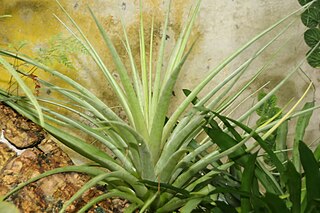
Tillandsia capitata is a species of flowering plant in the family Bromeliaceae. It is native to Mexico, Honduras, Cuba and the Dominican Republic.
Tillandsia compacta is a species of flowering plant in the family Bromeliaceae. This species is native to Cuba, Hispaniola, Colombia, Bolivia, Venezuela and Ecuador.

Calathea picturata is a species of plant in the family Marantaceae, native to northwest Brazil. It is a clump-forming evergreen perennial growing to 35–40 cm (14–16 in). The leaves are dark green above, purple below, marked heavily with silver along the veins and midriff. It is tender, with a minimum temperature of 16 °C (61 °F) required, and in temperate areas is cultivated indoors as a houseplant.
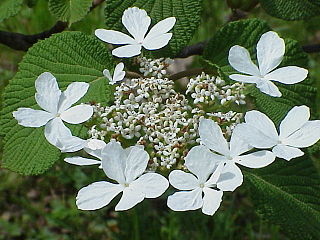
Viburnum furcatum, the forked viburnum or scarlet leaved viburnum, is a species of flowering plant in the family Adoxaceae. Growing to 4 m (13 ft) tall and broad, it is a substantial deciduous shrub with rounded oval bronze-green leaves, turning red in autumn. Scented white flower-heads resembling those of lacecap hydrangeas are borne in summer, followed by black fruits.

Melaleuca argentea, commonly known as the silver cadjeput, silver-leaved paperbark, silver cajuput, or mardderr in the Kunwinjku language, is a plant in the myrtle family, Myrtaceae and is endemic to northern Australia. It is a common tree along river banks or around swamps in the tropics. It has papery bark and weeping foliage and has been the subject of important scientific research.

Ranunculus gramineus, called the grass-leaved buttercup, is a species of flowering plant in the genus Ranunculus, native to the western Mediterranean; Morocco, Algeria, Tunisia, Portugal, Spain, France, Italy, and Switzerland. It has gained the Royal Horticultural Society's Award of Garden Merit.
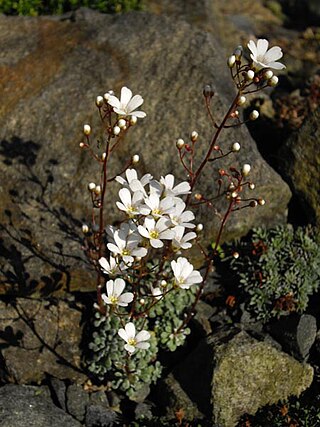
Saxifraga cochlearis, called the spoon-leaved saxifrage, is a species of flowering plant in the genus Saxifraga, native to the Alpes Maritimes of France and the adjoining Italian region of Liguria. Its 'Minor' subtaxon has gained the Royal Horticultural Society's Award of Garden Merit.

Bistorta vacciniifolia, the whortleberry-leaved knotweed, is a species of flowering plant in the family Polygonaceae, native to Tibet and the Himalaya. Well-suited for clay soils, as its synonym Persicaria vacciniifolia it has gained the Royal Horticultural Society's Award of Garden Merit.
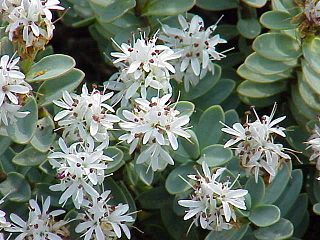
Veronica pinguifolia, the disk-leaved hebe or thick-leaved speedwell, is a species of flowering plant in the family Plantaginaceae, native to the South Island of New Zealand. Under its synonym Hebe pinguifolia, its cultivar 'Pagei' has gained the Royal Horticultural Society's Award of Garden Merit.

Dichondra argentea, the silver ponysfoot or silver nickel vine, is a species of flowering plant in the family Convolvulaceae. It is disjunctly distributed in New Mexico, Texas, Mexico, Colombia, Bolivia, northwest Argentina, and southeast Brazil, and has gone extinct in Arizona. A creeping perennial reaching 4 in (10 cm) high but growing 4 to 6 ft long, and hardy in USDA zones 10 through 12, in cultivation it is grown as annual, chiefly as a hanging accent plant or ground cover. There is a cultivar, 'Silver Falls'.
